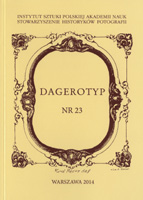Z Bolesławca do Görlitz – historia fotograficznej rodziny Scholzów
From Bolesławiec to Görlitz – the story of Scholz photographers family
Author(s): Zygmunt WielowiejskiSubject(s): Fine Arts / Performing Arts, Photography
Published by: Instytut Sztuki Polskiej Akademii Nauk
Keywords: photography; german photography; silesian photography; vintage photography; old photographic technique; daguerreotype; portrait photography; Scholz family; Silesia; Scholz; Robert; Scholz; Joahann Wilhelm Eduard; Scholz; Otto; Bunzlau; Görlitz
Summary/Abstract: The article is primarily devoted to the photographic activeness of Joahann Wilhelm Eduard Scholz (1815-1891) and his sons Robert (1843-1926) and Otto (1844-1908). Initially, Eduard Schulz painted local porcelain works. His first daguerreotypes come from the period of 1845-1846 (ill. 3-10). In 1847 he opened a daguerreotype workshop located in Bolesławiec (Bunzlau) at 59 Square (ill.1-2). The business also comprised the sales of ceramics, art glass, silk, and spectacles. In 1858 he introduced ambrotypes and pannotypes into his works collection, and later in 1863 he extended it by carte de visite photographs. He was also seasonally absent at the end of the 40s and 50s. Szczawno Zdrój (Salzbrunn), Cieplice (Warmbrunn), Lwówek (Löwenberg), and Jelenia Góra (Hirschberg) were his favourite destinations of that time. At the age of 57, withdrawn from the photographic and trade business in Bolesławiec (Bunzlau), Schulz moved to Nowogrodziec (Naumburg) where, in 1872, he opened another photography workshop. He kept, however, his share in the family company in Bolesławiec (Bunzlau) and Görlitz, i.e. Ed. Schulz & Sine. The workshop in Görlitz was set up in 1867 by his former apprentice, son Robert. Originally situated at 12 Klosterstrasse the business was later located at 8 Bismarckstrasse where Robert’s family resided. Robert’s works ranged from portraits and landscapes to architecture and various current events. He took part in several exhibitions too. In 1893 he extended his workshop by collotype and zincography. After the father’s death (1891) the workshop in Bolesławiec (Bunzlau) was inherited by his sons Otto and following his death (1908) by Robert, respectively. Since the beginning of the 1920s Robert’s sons – Alfred and Felix - were the company proprietors. In 1949 its remains were overtaken by Artur Kühn, and in 1970 it was eventually liquidated. The concluding lines of the article are devoted to broad press releases which mention a stone statue erected in Bolesławiec (Bunzlau) in order to commemorate Eduard Scholz’s 14th death anniversary (1915).
Journal: Dagerotyp
- Issue Year: 2014
- Issue No: 23
- Page Range: 5-30
- Page Count: 26
- Language: Polish
- Content File-PDF

